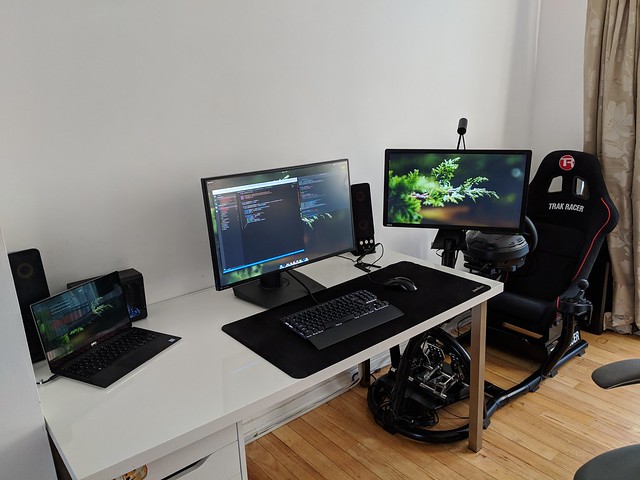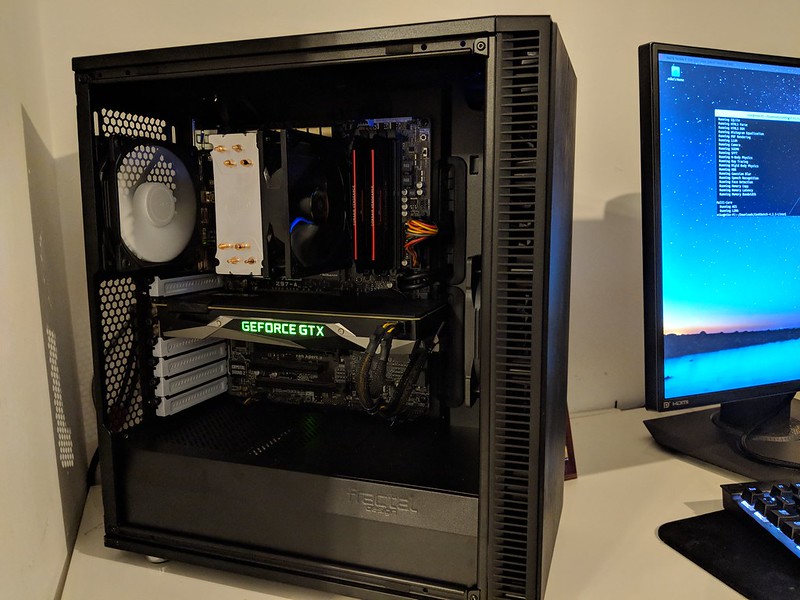Associate
- Joined
- 19 Dec 2017
- Posts
- 720
For the longest time, I've always maintained a very distinct separation between gaming and productivity in the form of a gaming PC (4690k, 1080GTX) for the former and a Macbook Pro for the latter.
The issue I had with this was the Gaming PC was rarely used, as it was essentially useless when not gaming and the Macbook Pro was a very expensive means to get some development work done.
I've long loved the idea of having one single computer for everything. Mostly because it means that whatever I'm working on at my desk at home, I can pick up anywhere else, so long as I've brought my laptop with me (It tends to come everywhere with me). It also means that I would get a little more value out of the money I spend on gaming hardware.
So when I noticed ultralites are now coming with quad core CPUs that perform was well as the 4690k in my gaming PC, my interest peaked. Not only that, but these laptops now come with 4 lane PCI-e Thunderbolt 3, meaning eGPUs are starting to become properly practical.
I managed to find a Dell XPS (8550u, 16gb Ram, 512GB SSD) and an Aorus 1080 Gaming Box for around £1500 for the pair - both manufacturer refurbished items.
I use Linux for my development/productivity work and getting that working with the eGPU was no simple challenge.
My first go to was Ubuntu 18.04 which had very intermittent support for the eGPU - sometimes I would get a display on the screen attached to the eGPU, other times I would not. I understood I need nvidia drivers to run `prime-select` but I just could not get them to work reliably with nouveau persistently loading no matter what I tried.
So I took a step back and remembered my desire to checkout Elementary OS which is based on Ubuntu 16.04. This worked perfectly and I was able to use `prime-select` with a bit of inspiration, I came up with a couple of scripts (https://github.com/mikehhhhhhh/egpuscripts) to dock and undock the laptop. Later on, I'd like to see if it's possible without losing my current session.
Windows setup by comparison was super easy - it pretty much worked out of the box.
It's working great so far. I've yet to checkout the sim racing/VR stuff - the interesting part about that is that I'll be running these games from an external USB3 SSD plugged into the eGPU enclosure. I guess the question is not only how that will perform, but how it'll impact graphics performance as it's sharing it's bandwidth with the graphics card, but I'll be sure to report my findings back here.
Most importantly, I've achieved one cable docking, too!
 IMG_20180713_181917 (1) by mikehhhhhhh, on Flickr
IMG_20180713_181917 (1) by mikehhhhhhh, on Flickr
The issue I had with this was the Gaming PC was rarely used, as it was essentially useless when not gaming and the Macbook Pro was a very expensive means to get some development work done.
I've long loved the idea of having one single computer for everything. Mostly because it means that whatever I'm working on at my desk at home, I can pick up anywhere else, so long as I've brought my laptop with me (It tends to come everywhere with me). It also means that I would get a little more value out of the money I spend on gaming hardware.
So when I noticed ultralites are now coming with quad core CPUs that perform was well as the 4690k in my gaming PC, my interest peaked. Not only that, but these laptops now come with 4 lane PCI-e Thunderbolt 3, meaning eGPUs are starting to become properly practical.
I managed to find a Dell XPS (8550u, 16gb Ram, 512GB SSD) and an Aorus 1080 Gaming Box for around £1500 for the pair - both manufacturer refurbished items.
I use Linux for my development/productivity work and getting that working with the eGPU was no simple challenge.
My first go to was Ubuntu 18.04 which had very intermittent support for the eGPU - sometimes I would get a display on the screen attached to the eGPU, other times I would not. I understood I need nvidia drivers to run `prime-select` but I just could not get them to work reliably with nouveau persistently loading no matter what I tried.
So I took a step back and remembered my desire to checkout Elementary OS which is based on Ubuntu 16.04. This worked perfectly and I was able to use `prime-select` with a bit of inspiration, I came up with a couple of scripts (https://github.com/mikehhhhhhh/egpuscripts) to dock and undock the laptop. Later on, I'd like to see if it's possible without losing my current session.
Windows setup by comparison was super easy - it pretty much worked out of the box.
It's working great so far. I've yet to checkout the sim racing/VR stuff - the interesting part about that is that I'll be running these games from an external USB3 SSD plugged into the eGPU enclosure. I guess the question is not only how that will perform, but how it'll impact graphics performance as it's sharing it's bandwidth with the graphics card, but I'll be sure to report my findings back here.
Most importantly, I've achieved one cable docking, too!
 IMG_20180713_181917 (1) by mikehhhhhhh, on Flickr
IMG_20180713_181917 (1) by mikehhhhhhh, on Flickr

 IMG_20180717_212454
IMG_20180717_212454